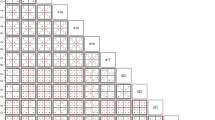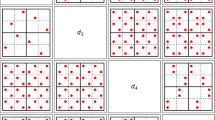Abstract
Strong orthogonal arrays were recently introduced as a new class of space-filling designs for computer experiments due to their better stratifications than orthogonal arrays. To further improve the space-filling properties in low dimensions while possessing the column orthogonality, we propose column-orthogonal strong orthogonal arrays of strength two star and three. Construction methods and characterizations of such designs are provided. The resulting strong orthogonal arrays, with the numbers of levels being increased, have their space-filling properties in one and two dimensions being strengthened. They can accommodate comparable or even larger numbers of factors than those in the existing literature, enjoy flexible run sizes, and possess the column orthogonality. The construction methods are convenient and flexible, and the resulting designs are good choices for computer experiments.


Similar content being viewed by others
References
Bingham D, Sitter RR, Tang B (2009) Orthogonal and nearly orthogonal designs for computer experiments. Biometrika 96:51–65
Fang KT, Li R, Sudjianto A (2006) Design and modeling for computer experiments. Chapman & Hall, Boca Raton
Fang KT, Liu MQ, Qin H, Zhou YD (2018) Theory and application of uniform experimental designs. Springer-Science Press, Singapore, Beijing
He Y, Cheng CS, Tang B (2018) Strong orthogonal arrays of strength two plus. Ann Stat 46:457–468
He Y, Tang B (2013) Strong orthogonal arrays and associated Latin hypercubes for computer experiments. Biometrika 100:254–260
He Y, Tang B (2014) A characterization of strong orthogonal arrays of strength three. Ann Stat 42:1347–1360
Hedayat AS, Sloane NJA, Stufken J (1999) Orthogonal arrays: theory and applications. Springer, New York
Hickernell FJ (1998) A generalized discrepancy and quadrature error bound. Math Comp 67:299–322
Johnson ME, Moore LM, Ylvisaker D (1990) Minimax and maximin distance designs. J Stat Plann Inference 26:131–148
Lin CD, Mukerjee R, Tang B (2009) Construction of orthogonal and nearly orthogonal Latin hypercubes. Biometrika 96:243–247
Liu HY, Liu MQ (2015) Column-orthogonal strong orthogonal arrays and sliced strong orthogonal arrays. Stat Sinica 25:1713–1734
McKay MD, Beckman RJ, Conover WJ (1979) Comparison of three methods for selecting values of input variables in the analysis of output from a computer code. Technometrics 21:239–245
Owen AB (1992) Orthogonal arrays for computer experiments, integration and visualization. Stat Sinica 2:439–452
Santner TJ, Williams BJ, Notz WI (2013) The design and analysis of computer experiments. Springer, New York
Shi C, Tang B (2020) Construction results for strong orthogonal arrays of strength three. Bernoulli 26:418–431
Steinberg DM, Lin DKJ (2006) A construction method for orthogonal Latin hypercube designs. Biometrika 93:279–288
Sun FS, Liu MQ, Lin DKJ (2009) Construction of orthogonal Latin hypercube designs. Biometrika 96:971–974
Sun FS, Wang Y, Xu H (2019) Uniform projection designs. Ann Stat 47:641–661
Tang B (1993) Orthogonal array-based Latin hypercubes. J Am Stat Assoc 88:1392–1397
Vazquez E, Bect J (2011) Sequential search based on kriging: convergence analysis of some algorithms. In: Proceedings of the 58th World Statistical Congress of the ISI, pp 1241–1250
Xiao Q, Xu H (2018) Construction of maximin distance designs via level permutation and expansion. Stat Sinica 28:1395–1414
Ye KQ (1998) Orthogonal column Latin hypercubes and their application in computer experiments. J Am Stat Assoc 93:1430–1439
Zhou YD, Tang B (2019) Column-orthogonal strong orthogonal arrays of strength two plus and three minus. Biometrika 106:997–1004
Acknowledgements
The authors are grateful to Editor Professor Werner G. Müller and two anonymous referees for their insightful comments and suggestions. We also thank Professors Boxin Tang and Yong-Dao Zhou for their valuable comments. This work was supported by the National Natural Science Foundation of China (Grant Nos. 11771220 and 11871033), National Ten Thousand Talents Program of China, Fundamental Research Funds for the Central Universities (63211090), and Natural Science Foundation of Tianjin (20JCYBJC01050). The authorship is listed in alphabetical order.
Author information
Authors and Affiliations
Corresponding author
Additional information
Publisher's Note
Springer Nature remains neutral with regard to jurisdictional claims in published maps and institutional affiliations.
Appendix: Proofs of theorems
Appendix: Proofs of theorems
Proof of Theorem 2
From (3) and (4), we have \(D^*= C^*R\), where \(C^*=(C_1^*, \dots ,\) \(C_p^*)\) and \(R=\mathrm{diag}\{V,\dots ,V\}\) with V repeating p times. Since \((a_i, a_j, b_j)\) is an OA of strength 3 for any \(i \ne j\), \(C^*\) is an OA of strength 2 with levels from \(\Omega (s)\). By noting that R is column-orthogonal, we have \({D^*}^T D^*=(C^* R)^T C^* R = R^T ({C^*}^T C^*) R = c_1 R^T R=c_2I_{2p}\), where \(c_1\) and \(c_2\) are two constants, and \(I_{2p}\) is the identity matrix of order 2p. This shows that \(D^*\) in (3) is column-orthogonal. So is D in (5).
Before showing the stratifications of D, we first derive the form of any column d of D in (5). Let \(a_i^*=a_i- (s-1)/2\) and \(b_i^*=b_i- (s-1)/2\) for \(i=1,\dots , m\). Note that the column \(d^*\) of \(D^*\) in (3) corresponding to d has the form \(d^*=c_1^*s^2 + c_2^*s \pm c_3^*,\) where \((c_1^*, c_2^*, c_3^*)\) is a copy of some \(( a_j^*, b_j^*,a_i^*)\) with \(i \ne j\). From (5), the column d of D has the form
where \(r_1=c_1^* +(s-1)/2\), \(r_2= c_2^* + (s-1)/2\) and \(r_3=\pm c_3^* + (s-1)/2\). Since \((c_1^*, c_2^*, c_3^*)\) is a copy of some \(( a_j^*, b_j^*, a_i^*)\) with \(i \ne j\), then \((r_1, r_2, r_3)\) is a copy of \(( a_j, b_j, a_i)\) or \(( a_j, b_j, s-1-a_i)\). Thus, all entries of \((r_1, r_2, r_3)\) take values in \(\{0, 1, \dots , s-1\} \times \{0, 1, \dots , s-1\} \times \{0, 1, \dots , s-1\}\). Therefore, we have that for \(i \ne j\), any column d of D in (5) has the form \(d=a_j s^2 + b_j s + a\) where \(a=a_{i}\) or \(a=s-1 - a_{i}\).
We now show the stratifications of D. For any two columns \(d_i=a_i s^2 + b_i s + a_{i'}\) and \(d_j=a_j s^2 + b_j s + a_{j'}\), let us show that the array \((d_i, d_{j})\) can be collapsed into an OA\((n,2,s^2 \times s, 2)\) and an OA\((n,2,s \times s^2, 2)\), that is to say, \((\lfloor d_i/s \rfloor , \lfloor d_j/s^2 \rfloor )=(a_i s +b_i, a_j)\) and \((\lfloor d_i/s^2 \rfloor , \lfloor d_j/s \rfloor )=(a_i, a_j s + b_j )\) are an OA\((n,2,s^2 \times s, 2)\) and an OA\((n,2,s \times s^2, 2)\), respectively. In fact, this is true by noting the following three facts: (i) \((a_i, a_j, b_j)\) is an OA(n, 3, s, 3) for any \(i\ne j\); (ii) \(x_1 s+x_2\) establishes a one-to-one correspondence between the \(s^2\) levels in \(\{0, 1, \dots , s^2-1\}\) and the \(s^2\) pairs \((x_1, x_2)\), where \(x_1, x_2 \in \{0, 1, \dots , s-1\}\); (iii) \(x_1 s^2 + x_2 s + x_3\) establishes a one-to-one correspondence between the \(s^3\) levels in \(\{0, 1, \dots , s^3-1\}\) and the \(s^3\) pairs \((x_1, x_2, x_3)\), where \(x_1, x_2, x_3 \in \{0, 1, \dots , s-1\}\). Therefore, D satisfies the property of stratifications in Definition 1. This completes the proof. \(\square \)
Proof of Theorem 4
From the definition of two-level OA and Construction 1, m must be a multiple of 4 and \(p= \lfloor (m-1)/2 \rfloor =(m-2)/2\). Therefore the number of columns for the constructed OSOA is \(m-2\). According to the structures of A and B in (6), A is an OA\((2m, m-1, 2, 3)\) and B is an OA\((2m, m-1, 2, 2)\). Since \(b_j\) is orthogonal to the interaction column \(a_i a_j\) for any \(i \ne j\), \((a_i, a_j, b_j)\) is an OA(2m, 3, 2, 3). Then from Theorem 3, the resulting design is an OSOA\((2m, m-2, 8, 3)\). The proof is completed. \(\square \)
Proof of Theorem 5
Note that \(A=(a_1, \dots ,a_m)\) and \(B=(b_1, \dots , b_m)\) with \(m=(s^{k-1})/(s-1)\). From Theorem 2, we only need to show \((a_i, a_j, b_j)\) is an OA(n, 3, s, 3) for any \(i \ne j\). To do so, we assume that \(b_j\) is the interaction column of \(a_i\) and \(a_j\), i.e.,
holds for some \(l, t \in \{1, \dots ,s-1 \}\). Note that \(a_i=b_i e_k\) and \(a_j=b_j e_k\). So Equation (8) is possible to hold only when \(l=s-1\). However, if \(l=s-1\), Equation (8) implies that \(b_i b_j^{s-1}=b_j^t\) for some \(t\in \{1, \dots ,s-1 \}\). This is impossible because \(b_i\) and \(b_j\) are two different columns of B. This completes the proof. \(\square \)
Rights and permissions
About this article
Cite this article
Li, W., Liu, MQ. & Yang, JF. Construction of column-orthogonal strong orthogonal arrays. Stat Papers 63, 515–530 (2022). https://doi.org/10.1007/s00362-021-01249-w
Received:
Revised:
Accepted:
Published:
Issue Date:
DOI: https://doi.org/10.1007/s00362-021-01249-w




